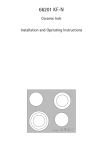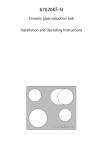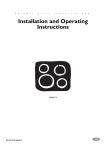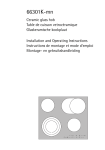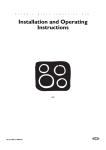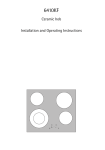Download Electrolux 79301 KF-MN Range User Manual
Transcript
79301 KF-MN Ceramic hob Installation and Operating Instructions Dear Customer, Please read these user instructions carefully and keep them to refer to later. Please pass the user instructions on to any future owner of the appliance. 1 3 2 2 The following symbols are used in the text: Safety instructions Warning! Notes that concern your personal safety. Important! Notes that show how to avoid damage to the appliance. Useful tips and hints Environmental information Contents Operating Instructions . . . . . . . . . . . . . . . . . . . . . . . . . . . . . . . . . . . . . 4 Safety instructions. . . . . . . . . . . . . . . . . . . . . . . . . . . . . . . . . . . . . . . . . . . . . . 4 Description of the Appliance . . . . . . . . . . . . . . . . . . . . . . . . . . . . . . . . . . . . . Cooking zones and control panel. . . . . . . . . . . . . . . . . . . . . . . . . . . . . . . . . . . Digital displays . . . . . . . . . . . . . . . . . . . . . . . . . . . . . . . . . . . . . . . . . . . . . . . . . . Safety cut-out function for the cooking zones . . . . . . . . . . . . . . . . . . . . . . . 6 6 7 7 Operating the hob . . . . . . . . . . . . . . . . . . . . . . . . . . . . . . . . . . . . . . . . . . . . . . Touch Control sensor field . . . . . . . . . . . . . . . . . . . . . . . . . . . . . . . . . . . . . . . . Switching on the appliance . . . . . . . . . . . . . . . . . . . . . . . . . . . . . . . . . . . . . . . Switching off the appliance . . . . . . . . . . . . . . . . . . . . . . . . . . . . . . . . . . . . . . . Heat settings selecting . . . . . . . . . . . . . . . . . . . . . . . . . . . . . . . . . . . . . . . . . . . Keep warm setting. . . . . . . . . . . . . . . . . . . . . . . . . . . . . . . . . . . . . . . . . . . . . . . Switching the triple ring zone on and off . . . . . . . . . . . . . . . . . . . . . . . . . . . Switching the casserole zone on and off . . . . . . . . . . . . . . . . . . . . . . . . . . . . STOP+GO function. . . . . . . . . . . . . . . . . . . . . . . . . . . . . . . . . . . . . . . . . . . . . . . Switching off a cooking zone. . . . . . . . . . . . . . . . . . . . . . . . . . . . . . . . . . . . . . Residual Heat Indicator . . . . . . . . . . . . . . . . . . . . . . . . . . . . . . . . . . . . . . . . . . . Cooking using the automatic warm up function . . . . . . . . . . . . . . . . . . . . . . Cooking without the automatic warm up function. . . . . . . . . . . . . . . . . . . . Child safety lock. . . . . . . . . . . . . . . . . . . . . . . . . . . . . . . . . . . . . . . . . . . . . . . . . Timer . . . . . . . . . . . . . . . . . . . . . . . . . . . . . . . . . . . . . . . . . . . . . . . . . . . . . . . . . . 8 8 8 8 9 9 10 12 13 13 14 14 15 16 18 Uses, tables and tips . . . . . . . . . . . . . . . . . . . . . . . . . . . . . . . . . . . . . . . . . . . . Pans . . . . . . . . . . . . . . . . . . . . . . . . . . . . . . . . . . . . . . . . . . . . . . . . . . . . . . . . . . . Advice on cooking with and without automatic warm up . . . . . . . . . . . . . . Settings for Cooking on the Zones . . . . . . . . . . . . . . . . . . . . . . . . . . . . . . . . . 22 22 23 24 Cleaning and care . . . . . . . . . . . . . . . . . . . . . . . . . . . . . . . . . . . . . . . . . . . . . . 25 Metal décor strips . . . . . . . . . . . . . . . . . . . . . . . . . . . . . . . . . . . . . . . . . . . . . . . 26 What to do if … . . . . . . . . . . . . . . . . . . . . . . . . . . . . . . . . . . . . . . . . . . . . . . . . 26 Rectifying faults . . . . . . . . . . . . . . . . . . . . . . . . . . . . . . . . . . . . . . . . . . . . . . 26 Disposal . . . . . . . . . . . . . . . . . . . . . . . . . . . . . . . . . . . . . . . . . . . . . . . . . . . . . . . 28 Installation Instructions . . . . . . . . . . . . . . . . . . . . . . . . . . . . . . . . . . . 29 Installation proud of the work surface . . . . . . . . . . . . . . . . . . . . . . . . . . . . 30 Assembly . . . . . . . . . . . . . . . . . . . . . . . . . . . . . . . . . . . . . . . . . . . . . . . . . . . . . . 31 Warranty conditions . . . . . . . . . . . . . . . . . . . . . . . . . . . . . . . . . . . . . . . Service and Spare Parts 34 . . . . . . . . . . . . . . . . . . . . . . . . . . . . . . . . . . . 35 3 Operating Instructions 1 Safety instructions 3 5 Please comply with these instructions. If you do not, any damage resulting is not covered by the warranty. This appliance conforms with the following EU Directives: – 73/23/EEC dated 19.02.1973 Low Voltage Directive – 89/336/EEC dated 03.05.1989 EMC Directive inclusive of Amending Directive 92/31/EEC – 93/68/EEC dated 22.07.1993 CE Marking Directive Correct use • This appliance should be used only for normal domestic cooking and frying of food. • The appliance must not be used as a work surface or as a storage surface. • Additions or modifications to the appliance are not permitted. Child safety • Small children must be kept away from the appliance. • Only let older children work on the appliance under supervision. General safety • The appliance may only be installed and connected by trained, registered service engineers. • Built-in appliances may only be used after they have built in to suitable built-in units and work surfaces that meet standards. • In the event of faults with the appliance or damage to the glass ceramic (cracks, scratches or splits), the appliance must be switched off and disconnected from the electrical supply. • Repairs to the appliance must only be carried out by trained registered service engineers. 4 Safety during use • Remove stickers and film from the glass ceramic. • There is the risk of burns from the appliance if used carelessly. • Cables from electrical appliances must not touch the hot surface of the appliance or hot cookware. • Overheated fat and oil can ignite quickly. When cooking with fat or oil (e.g. frying chips) do not leave the appliance unattended. • Switch the cooking zones off after each use. Safety when cleaning • For cleaning, the appliance must be switched off and cooled down. • For safety reasons, the cleaning of the appliance with steam jet or high-pressure cleaning equipment is not permitted. How to avoid damage to the appliance • The ceramic glass can be damaged by objects falling onto it. • The edge of the ceramic glass can be damaged by being knocked by the cookware. • Cookware made of cast iron, cast aluminium or with damaged bottoms can scratch the ceramic glass if pushed across the surface. • Objects that melt and things that boil over can burn onto the ceramic glass and should be removed straightaway. • Do not use the cooking zones with empty cookware or without cookware. 5 Description of the Appliance Cooking zones and control panel Single ring cooking zone 1200W Control Panel Triple ring cooking zone 2300W Casserole zone 2200W Control Panel Single ring cooking zone 1800W Sensor panel ”Stop+Go” “Timer” with Pilot indicators Sensor field ”On/Off” Browning zone sensor panel Three-ring control lamps Three-ring sensor panel Browning zone control lamp Indicator for heat setting/residual heat Heat setting selection 6 Digital displays The four display panels that belong to the four cooking zones indicate: – ¾ after having been switched on, – u when a keep warm setting has been selected, – ¿ to Ç, depending on the cooking setting selected, – 2 to 6 (with decimal point) for intermediate cooking settings, – a when the automatic warm up function is in operation, – h when there is residual warmth, – l when the child safety device has been switched on, – e when there is a malfunction 1 Safety cut-out function for the cooking zones If one of the cooking zones is not switched off after a certain period of time or the cooking setting is not altered, that particular cooking zone will automatically switch itself off. Any residual warmth will be indicated with h (as for “hot”) in the digital displays corresponding to the particular cooking zones. The cooking zones switch themselves off when: • Heat setting u, 1 - 2 after 6 hours • Heat setting 3-4 after 5 hours • Heat setting 5 after 4 hours • Heat setting 6-9 after 1.5 hours 3 Should one or more cooking zones switch themselves off before the periods of time indicated have elapsed, see the chapter “What to do if …”. Other causes for a cooking zone switching itself off All cooking zones will immediately switch themselves off if liquid boils over and lands on the control panel. The same thing will happen if you place a damp cloth on the control panel. In both instances, after the liquid or cloth has been removed, the appliance will need to be switched on again using the main switch I. 7 Operating the hob Touch Control sensor field To operate the Touch Control sensor field place your finger from above flat onto the required field until the appropriate displays come on or go out or the required function is carried out. Switching on the appliance The entire appliance is switched on using the ”On/Off” sensor panel I. Touch the “On/Off” sensor panel for approx. two seconds. 3 8 The digital displays will show ¾. After the “On/Off” sensor panel has been actuated to switch on your appliance, a cooking setting must be selected for a cooking zone within approx. 10 seconds, or a time must be set using the timer (egg timer function). If not, the appliance will switch itself off again for reasons related to safety. Switching off the appliance To completely switch off the appliance, actuate the “On/Off” sensor panel I. Touch the “On/Off” sensor panel for approx. one second. 3 After switching off a single cooking zone or the entire cooking surface, the existing residual warmth will be displayed in the digital displays of the corresponding cooking zones in the form of h (for “hot”). Heat settings selecting For setting and changing the heat setting (u to Ç) for the selected cooking zone. Raise the heat setting using the heat setting selector sensor panel . Lower the heat setting using the heat setting selector sensor panel . Keep warm setting Each of the 4 cooking zones has a keep warm setting u. Use the heat setting selector sensor panel to set the keep warm setting u. 9 Switching the triple ring zone on and off 3 According to the size of the saucepan or frying pan, when using the triple ring cooking zone you can switch from a smaller cooking zone to a larger cooking zone using the “triple ring zone” sensor panel. You can only switch to the next size if a heat setting has already been set for the smaller heating ring. 1. Set the desired heat setting. 2. Touch the “triple ring” sensor panel. This will switch the setting to the centre heating ring. The lower control lamp will illuminate. 10 3. Touch the “triple ring” sensor panel to activate the outer heating ring. The upper control lamp will illuminate. 4. To switch off the outer heating ring, touch the “triple ring” sensor panel, and the heating ring that is outermost at the time will switch off. 11 Switching the casserole zone on and off 1. Set the desired heat setting. 2. To switch the casserole zone on or off, place your finger flat on the “casserole zone” sensor field until the indicator light illuminates or goes off. 12 STOP+GO function When the “Stop+Go” sensor panel is actuated all cooking zones that are switched on are simultaneously switched to the keep warm setting. The control light for the “Stop+Go” sensor panel will illuminate. The keep warm setting will be indicated in the display with u. 3 When the “Stop+Go” sensor panel is actuated again, the cooking settings that were previously selected are reset and the control light goes out. The timer is not stopped by the Stop+Go function. If an automatic warm up function was selected in the heating up stage a this will be stopped by the Stop+Go function, and the previously selected cooking setting will be reset by actuating the “Stop+Go” sensor panel again. Switching off a cooking zone 1. To switch off a cooking zone touch the heat setting selector sensor panel and simultaneously, or return the setting to zero using the heat setting selector sensor panel . 13 Residual Heat Indicator 2 1 1 When an individual cooking zone or the entire hob is switched off, any residual heat is shown with an h (for “Hot”) in the digital display for the appropriate cooking zones. Even after the cooking zone has been switched off, the residual heat indicator only goes out when the cooking zone is cold. You can use the residual heat for melting and keeping food warm. Important! As long as the residual heat indicator is illuminated, there is a risk of burns. Important! If the power supply is interrupted the h symbol will also go out and information about residual heat will no longer be available. However, it is still possible to burn yourself. This can be avoided by taking care around the hob. Cooking using the automatic warm up function All of the cooking surface’s four cooking zones can be adjusted to any of nine settings, and are equipped with an automatic warm up function: – ¿, lowest heat setting – Ç, highest heat setting – a, automatic warm up function. When you select the desired heat setting using the heat setting selector sensor panel, the cooking zone will operate at maximum power for a certain period of time and will then automatically switch back to the follow-on heat setting that has been set. The length of time that the automatic warm up function operates depends on the follow-on heat setting selected. 1. Touch the heat setting selector sensor panel to set the desired heat setting from ¿ to Æ. The heat setting that has been set will then be displayed. After a period of 5 seconds, the a (=automatic warm up function) will appear in the display in place of the heat setting. After 14 the warm up period has finished, the heat setting will once more be displayed. 3 If you should choose a higher heat setting while the automatic function is in operation, e.g. from Á to Ã, the period of time that the warm up function is in operation will be adjusted accordingly. If you select a lower setting, the warm up period will end immediately. You can cook using the automatic warm up function only if the cooking zone is cold or moderately warm. If a cooking zone is already hot when you switch it on (h indicator), the automatic warm up function cannot be used. Cooking without the automatic warm up function If you wish to use the cooking zones without the automatic warm up function, select the desired heat setting using the heat setting selector sensor panel . 1. Touch the heat setting selector sensor panel in order to set the desired heat setting from Ç to ¿. 3 You can change the setting at any time using the heat setting selector sensor panels and . 15 Child safety lock You can use the child safety lock to safeguard against unwanted use of the cooking surface. Switching on the child safety lock To be able to switch on the child safety lock the appliance must be switched on, but all the cooking zones must be switched off. 1. Touch the sensor field for approx. three seconds. An acoustic signal will sound as confirmation. 2. Touch any heat setting sensor field . l will appear in the displays, and the child safety lock is activated. The appliance will switch itself off automatically after a few seconds. 16 Overriding the child safety lock The child safety lock can be overridden in order to use the appliance (until the appliance is switched off again). When the appliance is switched on again the child safety device is activated once again. 1. Switch on the appliance. When the child safety device has been activated, l will be displayed. 2. Touch any two heat setting sensor fields and simultaneously. An acoustic signal will sound as confirmation. The child safety device has been overridden until the appliance is switched off, and the cooking surface can be used as normal. 17 Switching off the child safety lock 1. Switch on the appliance. When the child safety device has been activated, l will be displayed. 2. Touch the sensor field for approx. three seconds. An acoustic signal will sound as confirmation. 3. Touch any heat setting sensor field . The displays will become dark, and the child safety device is switched off. The appliance will switch itself off automatically after a few seconds. 18 Timer 3 There are two ways to use the timer: – as a safety cut-out function. Set a cooking period for a cooking zone, and after this time has elapsed the cooking zone will automatically switch itself off. This function can be used for more than one cooking zone simultaneously. – as a countdown timer without a cut-out function (“egg timer”), whereby an acoustic signal can be heard after the set period of time has elapsed. The countdown timer cannot be used if a cooking zone is switched on. Safety cut-out The cooking zone(s) for which you want to use the safety cut-out function must be switched on. 1. Using the timer sensor panel, select the cooking zone for which the safety cut-out is to be set. By touching the timer sensor panel once the first active cooking zone is selected in a clockwise direction, and the corresponding control lamp will flash rapidly. Hereby the (e.g.) left rear control lamp corresponds to the left rear cooking zone. 00 will appear in the timer display. The next active cooking zone is selected by touching the timer sensor panel again. 19 2. While the control lamp is flashing rapidly, use the + or - timersetting sensor panels to set the desired period of time for this cooking zone up until the point where it automatically switches itself off (e.g. 15 minutes). The safety cut-out function will be activated after several minutes The control lamp will now flash more slowly and the remaining cooking time will be shown in the display as it elapses. If the safety cut-out function has been set for more than one cooking zone, the time displayed will be that for the cooking zone with the shortest period of cooking time remaining. The control lamps for the other cooking zones for which the safety cut-out function has been set will illuminate. To display the remaining cooking time for any of these cooking zones, it must be selected using the timer sensor panel, and the corresponding control lamp will then flash rapidly. To reset the remaining cooking time the desired cooking zone must be selected using the timer sensor panel. The corresponding control lamp will then flash more rapidly. The settings are reset using the + or timer setting sensor panels. 3 20 After the set period of cooking time has elapsed the cooking zone automatically switches itself off, an acoustic signal sounds for two minutes and the timer display flashes 00. 3. To switch off the signal, touch the timer sensor panel. To make the setting more quickly, touch any of the + or - timer setting sensor panels until the desired value is reached. If the - timer setting sensor panel is actuated first, the time setting will begin at 99 minutes, and if the + timer setting sensor panel is actuated first, the time setting will begin at 1 minute. Switching off the safety cut-out function before it has come to an end There are two ways to switch off the safety cut-out function before it has come to an end. Switch off the cooking zone and timer simultaneously 1. Using the heat setting selector sensor panel, reset the desired cooking zone to zero: the cooking zone and timer will switch themselves off. Switch off the timer – the cooking zone remains active 1. Select the desired cooking zone using the timer sensor panel. The corresponding control lamp will then flash more rapidly. 2. Using the - timer setting sensor panel, set the timer to 00: – only the timer will switch itself off. – the cooking zone will remain in operation. Countdown timer To be able to use the countdown timer the appliance must be switched on, but all the cooking zones must be switched off. 1. Touch the timer sensor panel. 00 will be shown in the timer display. 2. Set the desired period of time using the + or - timer setting sensor panels. The countdown timer function will be activated after several minutes and the remaining time will be displayed. To reset the remaining time, touch the timer sensor panel and change the setting using the + or - sensor panels for setting the timer. After the set period of time has elapsed an acoustic signal sounds and the timer display flashes 00. 3. To switch off the signal, touch the timer sensor panel. 21 Uses, tables and tips Pans • You can recognise good pans by their bases. The base should be as thick and flat as possible. • Pay particular attention when buying new pans to the diameter of the base. Manufacturers often give only the diameter of the upper rim. • Pots with aluminium or copper bases can cause metallic discolouring on the ceramic glass surface, which is very difficult or impossible to remove. • Do not use cast iron pans or pans with a rough, burred or damaged base. This can produce permanent scratching if the pan is slid across the surface. • When cold, pan bases are normally bowed slightly inwards (concave). They should never be bowed outwards (convex). • If you wish to use special types of pan (e.g. a pressure cooker, simmering pan, wok, etc.), please observe the manufacturer's instructions. 2 22 Energy saving tips • Always position pots and pans before switching on the cooking zone. • Whenever possible always position the lids firmly on pots and pans to cover completely. • Switch off the cooking zones before the end of the cooking time to use the residual heat such as to keep foods warm or for melting. • The base of the pan should be the same size as the cooking zone. Advice on cooking with and without automatic warm up The automatic warm up function is suitable for: • dishes that start off cold, are heated up at high power and do not need to be continually watched when cooking on the selected heat setting, • dishes that are put in a hot frying pan. The automatic warm up function is not suitable for: • goulash, beef olives and similar braised dishes that need continual turning until browned correctly, have liquid added and are then braised until cooked, • dumplings, pasta dishes with large amounts of liquid, • cooking with pressure cookers, • very large quantities of soup/stew with more than 2 litres of liquid. General notes: • When cooking without the automatic warm up function, we recommend the use of a high heat setting to warm up the food (using the ) and then leave the dish to finish cooking at an appropriate lower heat setting. • Take special note of the results when you first use the appliance! You can then decide which heat setting is the best for "your dishes" in the "quantities you are accustomed to preparing" with "your pans". You will then quickly appreciate the advantages of the automatic function and will feel relaxed about using your new hob. 23 Settings for Cooking on the Zones The figures in the following table are benchmark figures. The switch setting required for a certain cooking method depends on the quality of the pans and the type and amount of food. Switch setting Automatic warm up function1) (min.) 9 8 Cooking method Examples for use Warming Sautéing Frying Warming large amounts of liquid, boiling noodles, searing meat, (browning goulash, braising meat) Steak, sirloin, hash browns, sausages, pancakes/griddle cakes 4,5 7 3,5 Intensive frying 6 2,0 Frying Schnitzel/chops, liver, fish, rissoles, fried eggs 5 10,2 4 6,5 Boiling Cooking up to 1.5 l liquid, potatoes, vegetables 3 4,8 2 1,7 Steaming Stewing Boiling Steaming and stewing of small amounts of vegetables, boiling rice and milk dishes 1 1,0 Melting Melting butter, dissolving gelatine, melting chocolate u 0,5 Keeping warm Keeping meals warm 1) When cooking without the automatic function the warm up period can be individually selected. 3 3 24 When warming or sautéing food we recommend that you set the appliance to warm up setting “9” and then, for food which requires a longer cooking time, switch to the appropriate follow on heat setting to finish cooking the food. Cleaning and care 1 1 1 Take care! Risk of burns from residual heat. Let the appliance cool down. Important Sharp objects and abrasive cleaning materials will damage the appliance. Clean with water and washing up liquid. Important Residues from cleaning agents will damage the appliance. Remove residues with water and washing up liquid. Cleaning the appliance after each use 1. Wipe the appliance with a damp cloth and a little washing up liquid. 2. Rub the appliance dry using a clean cloth. Removing deposits 1. Place the scraper on the glass ceramic surface at an angle. 2. Remove residues by sliding the blade over the surface. 3. Wipe the appliance with a damp cloth and a little washing up liquid. 4. Rub the appliance dry using a clean cloth. Remove Type of dirt imme- when the appliance has diately cooled down sugar, food containing sugar yes --- plastics, tin foil yes --- limescale and water rings --- yes fat splashes --- yes shiny metallic discolorations --- yes using a scraper* cleaner for glass ceramic or stainless steel* *Scrapers and cleaners for glass ceramic and stainless steel can be purchased in specialist shops 3 3 Remove stubborn residues with a cleaner for glass ceramic or stainless steel. Scratches or dark stains on the glass ceramic that cannot be removed do not however affect the functioning of the appliance. 25 Metal décor strips 1 Warning! Do not use vinegar, lemon juice or lime slaking agents on the cooking surface's décor strips, otherwise dull spots will result. When cleaning do not introduce flat objects (e.g. knives) under the décor strips, as otherwise these can possibly become detached. 1. Wipe metal décor strips with a damp cloth and a little washing up liquid. 2. Soak dried on spillages with a wet cloth. Afterwards wipe off and rub dry. What to do if … Rectifying faults 1 It is possible that faults have been caused by a minor error, which you can correct yourself with the help of the following instructions. Do not attempt any further repairs if the following instructions do not help in each specific case. Warning! Repairs to the appliance are only to be carried out by approved service engineers. Improperly effected repairs may result in considerable risk to the user. If your appliance needs repairing, please contact your specialist dealer or local Service Force Centre. If the ceramic glass hob is broken, please quote the 3-digit number on the glass hob when contacting customer service. What to do if … … the cooking zones are not functioning. Check whether – the fuse in the house wiring (fuse box) is intact. If the fuses trip a number of times, please call an authorised electrician. – the appliance is properly switched on, – the control lamps in the control panel are illuminated, – the relevant cooking zone is switched on, – the cooking zones are set at the desired settings, – the cooking zones’ safety switchoff function has been activated (see “Safety” chapter). 26 … you cannot switch on the cooking zones. Check whether – a period of more than 10 seconds has elapsed between when the On/ Off button was actuated and the desired cooking zone switches on (see chapter “Switching on the appliance”). – the sensor panels are partially covered by a damp cloth or liquid. … the display suddenly disappears except for h for residual warmth. Check whether – the On/Off button was accidentally actuated. – the sensor panels are partially covered by a damp cloth, liquid or similar. – the safety switchoff function has been activated. … after having switched off the cooking zones, no h for residual warmth is indicated in the display. Check whether – the cooking zone was only briefly used and therefore did not become hot enough. If the cooking zone is hot, please call customer service. … a cooking zone will not switch off. Check whether – the sensor switches are partially covered by a damp cloth or liquid. – the Stop+Go function is switched on. …a cooking zone will not switch on. Check whether – the child safety device is swiched on. – the Stop+Go function is switched on. … the e display is illuminated? Check whether the cooking zone has been overheated. This display illuminates in the event of overheating, errors in the electronic equipment or for reasons related to safety. … the appliance is not responding when a sensor panel is actuated. The appliance will not respond to a sensor panel being actuated if you are simultaneously touching another sensor panel that is not part of a combination. If you request a visit from customer service because of an error made in operating the appliance, a visit from a customer service engineer may not be free of charge even during the warranty period. 27 Disposal 2 2 28 Packaging material The packaging materials are environmentally friendly and can be recycled. The plastic components are identified by markings, e.g. >PE<, >PS<, etc. Please dispose of the packaging materials in the appropriate container at your local waste disposal facilities. Old appliance Please dispose of your old appliance in line with the guidelines for disposal in your area. Installation Instructions Safety instructions 1 1 The laws, ordinances, directives and standards in force in the country of use are to be followed (safety regulations, proper recycling in accordance with the regulations, etc.) Installation may only be carried out by a qualified electrician. The minimum distances to other appliances are to be observed. Drawers may only be installed with a protective board directly under the appliance. The cut surfaces of the work top are to be protected against moisture using a suitable sealant. The sealant seals the appliance to the work top with no gap. Do not use silicon sealant between the appliance and the work top. Avoid installing the appliance next to doors and under windows. Otherwise hot cookware may be knocked off the rings when doors and windows are opened. WARNING! Risk of injury from electrical current. • The electrical mains terminal is live. • Observe connection schematic. • Observe electrical safety rules. • Ensure anti-shock protection through correct installation by a qualified electrician. • The appliance must be connected to the electrical supply by a qualified electrician. IMPORTANT! Risk of injury from electrical current. Loose and inappropriate plug and socket connections can make the terminal overheat. • Have the clamping joints correctedly installed by a qualified electrician. • Use strain relief clamp on cable. A device must be provided in the electrical installation which allows the appliance to be disconnected from the mains at all poles with a contact opening width of at least 3 mm Suitable isolation devices include line protecting cut-outs, fuses (screw type fuses are to be removed from the holder), earth leakage trips and contactors. 29 Appliance dimensions Width Depth Height 710 mm 520mm 47mm Installation proud of the work surface • Clean the worktop in the area of the cut-out section. • Stick the one-sided self-adhesive sealing tape supplied all the way round the lower edge of the cooking surface along the outer edge of the glass ceramic panel. Do not stretch it. The cut ends should lie in the middle of one side. When you have cut it to length (add a few mm), press the two ends flush up against one another. 30 Assembly 31 32 33 Warranty conditions Great Britain Standard guarantee conditions We, AEG, undertake that if within 12 months of the date of the purchase this AEG appliance or any part thereof is proved to be defective by reason only of faulty workmanship or materials, we will, at our discretion repair or replace the same FREE OF CHARGE for labour, materials or carriage on condition that: • The appliance has been correctly installed and used only on the electricity or gas supply stated on the rating plate. • The appliance has been used for normal domestic purposes only, and in accordance with the manufacturer's operating and maintenance instructions. • The appliance has not been serviced, maintained, repaired, taken apart or tampered with by any person not authorised by us. • All service work under this guarantee must be undertaken by a Service Force Centre. Any appliance or defective part replaced shall become the Company's property. • This guarantee is in addition to your statutory and other legal rights. • Home visits are made between 8.30am and 5.30pm Monday to Friday. Visits may be available outside these hours in which case a premium will be charged. Exclusions This guarantee does not cover: • Damage or calls resulting from transportation, improper use or neglect, the replacement of any light bulbs or removable parts of glass or plastic. • Costs incurred for calls to put right an appliance which is improperly installed or calls to appliances outside the United Kingdom. • Appliances found to be in use within a commercial environment, plus those which are subject to rental agreements. • Products of AEG manufacture which are not marketed by AEG. European Guarantee If you should move to another country within Europe then your guarantee moves with you to your new home subject to the following qualifications: • The guarantee starts from the date you first purchased your product. • The guarantee is for the same period and to the same extent for labour and parts as exists in the new country of use for this brand or range of products. • This guarantee relates to you and cannot be transferred to another user. • Your new home is within the European Community (EC) or European Free Trade Area. • The product is installed and used in accordance with our instructions and is only used domestically, i.e. a normal household. • The product is installed taking into account regulations in your new country. Before you move please contact your nearest Customer Care centre, listed below, to give them details of your new home. They will then ensure that the local Service Organisation is aware of your move and able to look after you and your appliances. France Senlis +33 (0) 3 44 62 29 29 Germany Nürnberg +49 (0) 800 234 7378 Italy Pordenone +39 (0) 800 117511 Sweden Stockholm +46 (0) 8 672 5360 UK Slough +44 (0) 1753 219899 34 Service and Spare Parts If you wish to purchase spare parts or require an engineer, contact your local AEG Service Force Centre by telephoning: 08705 929 929 Your telephone call will be automatically routed to the Service Force Centre covering your post code area. For the address of your local Service Force Centre and further information about Service Force, please visit the website at www.serviceforce.co.uk When you contact the Service Centre they will need the following information: 1. Your name & address, including post code. 2. Your telephone number 3. Clear and concise details of the fault. 4. The model and serial number of the appliance (found on the rating plate). 5. The purchase date: Please note that a valid purchase receipt or guarantee documentation is required for in-guarantee service calls. Customer Care For general enquiries concerning your AEG appliance or for further information on AEG products please contact our Customer Care Department by letter or telephone at the address below or visit our website at www.aeg.co.uk. Customer Care Department AEG Domestic Appliances 55-77 High Street Slough Berkshire, SL1 1DZ Tel. 08705 350350 (*) (*) Calls may be recorded for training purposes. 35 From the Electrolux Group. The world´s No.1 choice. The Electrolux Group is the world´s largest producer of powered appliances for kitchen, cleaning and outdoor use. More than 55 million Electrolux Group products (such as refrigerators, cookers, washing machines, vacuum cleaners, chain saws and lawn mowers) are sold each year to a value of approx. USD 14 billion in more than 150 countries around the world. Hier Typenschild aufkleben (nur für Werk) AEG Hausgeräte GmbH Postfach 1036 D-90327 Nürnberg http://www.aeg.hausgeraete.de © Copyright by AEG 822 924 722-A-280104-01 Subject to change without notice




































